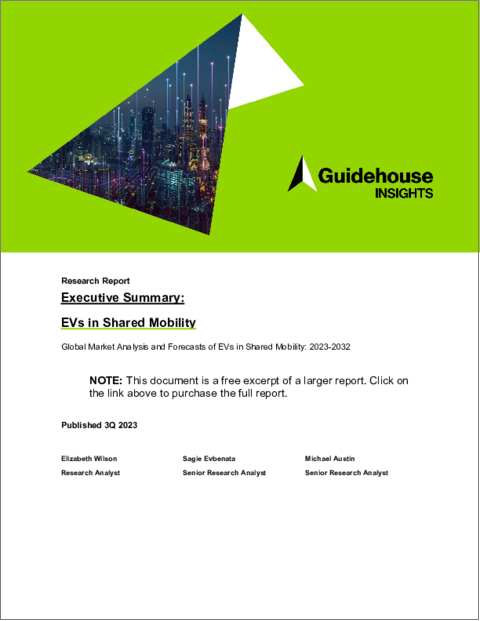|
|
市場調査レポート
商品コード
1345884
シェアードモビリティにおける電気自動車 (EV):シェアードモビリティ向けEVの世界市場の分析と予測 (2023年~2032年)EVs in Shared Mobility: Global Market Analysis and Forecasts of EVs in Shared Mobility, 2023-2032 |
||||||
|
|||||||
| シェアードモビリティにおける電気自動車 (EV):シェアードモビリティ向けEVの世界市場の分析と予測 (2023年~2032年) |
|
出版日: 2023年09月01日
発行: Guidehouse Research
ページ情報: 英文 36 Pages; 20 Tables, Charts & Figures
納期: 即納可能
|
- 全表示
- 概要
- 図表
- 目次
電気自動車 (EV) とそれに対応するEV充電インフラ市場は、政府の規制やインセンティブ、環境・社会・企業統治 (ESG) への関心に後押しされ、世界中で急速に成長しています。国の取り組みに加え、人口密集地の自治体も、排気ガス削減のために独自の法律を制定しています。一方、都市部での自動車保有は、コスト高で非効率的な状況が続いています。都市生活者が自動車保有コストの上昇、二酸化炭素排出量、より安価な複合交通手段を意識するようになるにつれ、個人での自動車保有は減少していくと思われます。このような消費者は、ライドヘイリング、カーシェアリングプログラム、法人向けリースなど、自動車の必要性を満たすためにシェアードモビリティに注目すると思われます。
これらのシェアードモビリティは、特定地域でのモビリティサービス企業を特定の対象とした法律とともに、各国・各地域で一層の強化が進んでいる自動車排出ガス規制に従うことが求められます。場合によっては、これらのサービスを利用する人々は、低排出ガスソリューションを求めており、そのため企業は保有車両をEVに移行する機会を探すようになります。シェアードモビリティサービスはOEMと提携して、ドライバーにEVと充電ソリューションを提供したり、乗客向けにEV専用のオプションを開発したりするケースが増えています。
本レポートでは、市場の促進要因 (温室効果ガス排出とESG報告に関する政府規制) や阻害要因 (車両の調達コストと入手可能性、充電インフラの制限、消費者の価格感応度) に注目しながら、シェアードモビリティサービスが提供する内燃機関車からEVへの移行について検証します。政府が補助金制度や規制を継続し、シェアードモビリティ・プラットフォームと充電ポイント事業者のパートナーシップが継続し、都市部ではシェアードモビリティサービスに対する消費者の需要が個人の自動車保有を上回るのであれば、シェアモビリティにおけるEVは予測期間中に成長する十分な機会があります。
目次
第1章 エグゼクティブサマリー
第2章 市場の問題
- 市場の内訳
- ライドヘイリング
- カーシェアリングプログラム
- 法人向けリース
- 技術の内訳
- バッテリー式電気自動車
- プラグインハイブリッド車
- 市場促進要因
- 政府の温室効果ガス排出規制
- 企業のESGへの懸念
- 市場の障壁
- 車両調達のコストと入手可能性
- 充電インフラ
- 消費者の価格感度
- 価格水準
- 消費者向けの価格水準
- フリート取得の価格水準
第3章 業界のバリューチェーン
- 競合情勢
- ビジネスモデルの進化
第4章 市場予測
- イントロダクション
- 範囲と調査手法
- 主な前提条件
- 車両販売と在庫
- 収益
第5章 結論・提言
- 3つの大きなポイント
- 提言
- 都市行政への提言
- シェアードモビリティサービス・プラットフォーム向け提言
- 充電サービス向け提言
第6章 頭字語・略語一覧
第7章 目次
第8章 図表
第9章 分析範囲・情報源・分析手法・注記
List of Tables
BEV & PHEV in Mobility Services By Region (Total)
BEV & PHEV in Mobility Services By Market (Total)
New BEV & PHEV in Mobility Services By Region
New BEV & PHEV in Mobility Services By Market
BEV Sales in Mobility Services By Market
PHEV Sales in Mobility Services By Market
BEV & PHEV Revenue in Mobility Services By Market
BEV & PHEV Revenue in Mobility Services By Region
BEV Revenue in Mobility Services By Market
PHEV Revenue in Mobility Services By Market
List of Figures
New EVs in Mobility Services By Region
EVs in Mobility Services By Region
EVs in Mobility Services By Market Segment
New EVs in Mobility Services By Market Segment
BEV Sales in Mobility Services By Market Segment
PHEV Sales in Mobility Services By Market Segment
BEV & PHEV Revenue in Mobility Services By Market Segment
BEV & PHEV Revenue in Mobility Services By Region
Pictorial Representation of the Value Chain
Regional Forecast Segmentation
The EV and corresponding EV charging infrastructure market, buoyed by government regulations and incentives and environmental, social, and corporate governance (ESG) concerns, is rapidly growing around the world. Along with national government initiatives, municipal governments in densely populated areas are instituting their own laws to cut down on tailpipe emissions. Meanwhile, car ownership in urban areas continues to be costly and inefficient. Individual car ownership is likely to decrease as city dwellers become more aware of rising ownership costs, their carbon footprints, and less costly multimodal transportation options. These consumers will likely look to shared mobility vehicles to meet their car needs-including ride-hailing, carshare programs, and corporate leasing.
These shared mobility vehicles will be required to follow increasingly stringent national and subnational regulations for vehicle emissions, along with laws specifically aimed at mobility services companies in certain regions. In some cases, those using these services will look for low emissions solutions, which will prompt companies to look for opportunities to transition their fleets to EVs. Increasingly, shared mobility services are partnering with OEMs to provide drivers with ready EVs and charging solutions and are developing EV-specific options for riders.
This report examines the transition of shared mobility services offerings from internal combustion engine (ICE) powered vehicles to EVs, with attention to market drivers (government regulations for greenhouse gas emissions and ESG reporting) and barriers (cost and availability of vehicle procurement, charging infrastructure limitations, and consumer price sensitivity). EVs in shared mobility have ample opportunity to grow over forecast period, provided that governments continue their subsidy programs and regulation, partnerships continue between shared mobility platforms and charge point operators, and consumer demand for shared mobility services exceeds individual car ownership in urban areas.
Table of Contents
1. Executive Summary
- 1.1 Introduction
- 1.2 Scope
- 1.3 Market Forecast
2. Market Issues
- 2.1 Market Segmentations
- 2.1.1 Ride-Hailing
- 2.1.2 Carshare Programs
- 2.1.3 Corporate Leasing
- 2.2 Technology Segmentations
- 2.2.1 Battery Electric Vehicles
- 2.2.2 Plug-In Hybrid Electric Vehicles
- 2.3 Market Drivers
- 2.3.1 Government Greenhouse Gas Emissions Regulations
- 2.3.1.1 National Regulations and Incentives
- 2.3.1.2 Local Regulations and Incentives
- 2.3.2 Corporate ESG Concerns
- 2.3.1 Government Greenhouse Gas Emissions Regulations
- 2.4 Market Barriers
- 2.4.1 Cost and Availability of Vehicle Procurement
- 2.4.2 Charging Infrastructure
- 2.4.3 Consumer Price Sensitivity
- 2.5 Pricing
- 2.5.1 Pricing for Consumer Use
- 2.5.2 Pricing for Fleet Acquisition
3. Industry Value Chain
- 3.1 Competitive Landscape
- 3.1.1 Business Model Evolution
4. Market Forecasts
- 4.1 Introduction
- 4.2 Scope and Methodology
- 4.3 Key Assumptions
- 4.4 Vehicle Sales and Stock
4.5 Revenue
5. Conclusions and Recommendations
- 5.1 Three Big Takeaways
- 5.2 Recommendations
- 5.2.1 Recommendations for Urban Governments
- 5.2.2 Recommendations for Shared Mobility Services Platforms
- 5.2.3 Recommendations for Charging Services






